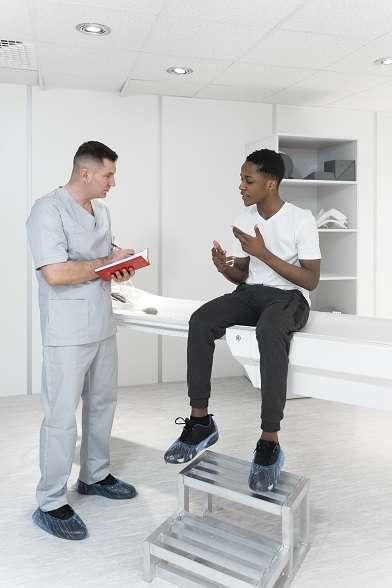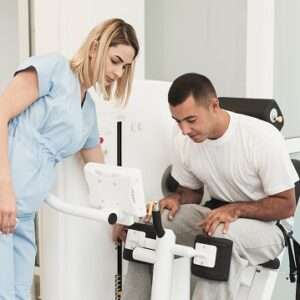
Motor Examination of Patients is a physical exam performed by a healthcare provider to assess the functioning of a patient’s motor system, which includes the muscles, nerves, and reflexes. Motor Examination of Patients typically involves several tests to evaluate the strength, tone, coordination, and reflexes of the patient’s limbs and other body parts.
During a motor examination, the healthcare provider may ask the patient to perform various movements and actions, such as gripping and releasing objects, moving the limbs in different directions, standing and walking, and performing other physical tasks. The provider will also assess the patient’s muscle tone by feeling the resistance to movement when the limbs are passively moved, as well as evaluating the patient’s reflexes by tapping on specific areas of the body with a reflex hammer.
Motor Examination of Patients is an essential diagnostic tool to help identify neurological conditions and disorders affecting the motor system, such as Parkinson’s disease, multiple sclerosis, and spinal cord injuries. It can also be used to monitor these conditions’ progression over time and evaluate the effectiveness of treatments.
Read More: Read more about Sensory Examination – Physiohealthexpert
Table of Contents
Components of Motor Examination of Patients
Components of Motor Examination of Patients are as follow,
- Muscle Strength
- Tone Of Muscles
- Coordination
- Reflexes
- Endurance
- Balance
How To Test Muscle Strength
There are various ways to test muscle strength during Motor Examination of Patients. Here are some standard methods:

Manual Muscle Testing: This method involves the healthcare provider asking the patient to perform a specific movement against resistance while the provider applies resistance to the tested limb. The provider then grades the strength of the muscle on a grading system of 0 to 5, with 0 illustrates no contraction and 5 showing normal strength.
Hand Grip Strength: This test uses a hand-held dynamometer to measure the patient’s grip force. The provider will ask the patient to squeeze the dynamometer as hard as possible, and the device will measure the power of the grip.
Range of Motion Testing: This method involves assessing the patient’s capability to move a joint through its full range of motion. The provider will ask the patient to move the joint actively and then passively move the joint through the same degree of movement to assess for any limitations.
Functional Testing: This method involves testing the patient’s ability to perform practical tasks, such as standing up from a chair or walking. The provider will assess the patient’s ability to complete the job and note any difficulties or limitations.
Electromyography (EMG): This diagnostic test involves inserting a needle electrode into the muscle to measure its electrical activity. The provider can use this test to assess muscle strength and diagnose neuromuscular conditions.
How To Check The Tone Of Muscles
Checking the tone of muscles is an integral part of Motor Examination of Patients. Here are some ways to prevent muscle tone:
Passive Range of Motion (PROM): PROM involves moving the patient’s limb through a range of motion while the patient is relaxed. The healthcare provider evaluates the resistance encountered during movement.
Active Range of Motion (AROM): AROM involves asking the patient to move their limb through a range of motion independently. The healthcare provider evaluates the quality and quantity of movement.
Resistance to Movement: Resistance to movement involves asking the patient to contract a muscle while the healthcare provider resists the motion. The healthcare provider evaluates the muscle contraction’s strength and the resistance level needed to overcome it.
Muscle Stretch Reflexes: Muscle stretch reflexes involve tapping a tendon with a reflex hammer while the muscle is stretched. The healthcare provider evaluates the muscle response.
Spasticity Assessment: Spasticity assessment evaluates the resistance to passive movement in a limb. The healthcare provider evaluates the resistance level and the muscle response quality.
The healthcare provider should also consider the patient’s age and any medical conditions affecting their muscle tone during Motor Examination of Patients.
How To Test The Coordination Of A Person
Testing a person’s coordination is an integral part of the neurological examination. Here are some ways to test coordination:
Finger-to-Nose Test: The finger-to-nose test involves asking the subject to touch their nose with their index finger while their eyes are closed. The healthcare provider then moves the patient’s finger to a different location, and the patient must touch their nose again.
Heel-to-Shin Test: The heel-to-shin test involves asking the patient to run their heel down the opposite shin from the knee to the ankle and back up again.
Rapid Alternating Movement Test: The rapid alternating movement test involves asking the patient to alternately touch their thumb to every finger on the same hand, then quickly reverse the movement and repeat.
Finger-to-Finger Test: The finger-to-finger test involves asking the subject to touch their index finger to the therapist’s index finger and then to their nose, alternating between the two.
Gait Assessment: Gait assessment involves observing the patient’s walk, noting any abnormalities such as stumbling or difficulty maintaining balance.
The healthcare provider should also consider the patient’s age and any medical conditions affecting their coordination during Motor Examination of Patients.
How To Check Reflexes
Checking reflexes is an integral part of Motor Examination of Patients. Here are the steps to check reflexes:
Position the patient comfortably: They should be relaxed and seated, with their arms and legs uncrossed.
Use a reflex hammer: A reflex hammer is a small rubber hammer used to tap on the patient’s tendons to elicit a reflex response.
Identify the tendon: The healthcare provider should identify the tendon associated with the reflex they want to test. For example, the patellar tendon is associated with the knee-jerk reflex.
Tap the tendon: The healthcare provider should tap the tendon with the reflex hammer, eliciting a brief stretch of the muscle fibres.
Observe the response: The healthcare provider should observe the patient’s response to the tap. A typical response is a quick muscle contraction, causing a slight limb movement. The reflex response should be equal on both sides of the body.
Record the findings: The healthcare provider should document the strength and symmetry of the reflex response.
The reflex examination usually includes testing several reflexes, including the knee-jerk reflex, ankle reflex, biceps reflex, triceps reflex, and brachioradialis reflex. A decreased or absent reflex response may indicate a nerve or muscle disorder, while an exaggerated reflex response may indicate a neurological condition.
It is important to note that reflex testing is just one part of the overall Motor Examination of Patients. It should be performed with other tests to evaluate the patient’s neurological status fully.
How To Test Endurance
Endurance testing is a way to evaluate a person’s ability to sustain physical activity over some time. Here are some ways to test endurance:

Timed Tests: Timed tests are a simple way to evaluate endurance. The healthcare provider can time the patient while they perform an activity such as walking, jogging, cycling, or swimming. The time taken to complete the action can be compared to normative data for the patient’s age and gender.
Distance Tests: Distance tests are similar to timed tests but measure the distance the patient covers in a specific amount of time. For example, the healthcare provider can ask the patient to walk as far as they can in six minutes and then record the distance covered.
Step Tests: Step tests are used to assess cardiovascular endurance. The most common step test is the Harvard Step Test, which involves stepping up and down a bench for three minutes while the heart rate is monitored. The test measures how long the heart rate takes to return to rest after the activity.
Maximal Oxygen Consumption (VO2 Max) Tests: VO2 Max tests are the gold standard for measuring endurance. The test involves performing an activity such as running on a treadmill or cycling while the healthcare provider measures the patient’s oxygen consumption. VO2 Max tests require specialized equipment and should only be performed by trained professionals.
Functional Tests: Functional tests assess endurance in the context of specific practical activities such as climbing stairs, carrying groceries, or performing other activities of daily living. The healthcare provider can observe the patient while they perform these activities and note any signs of fatigue or difficulty.
How To Check The Balance Of A Person
Checking a person’s balance is an integral part of a neurological examination. Here are some ways to check your balance:
Romberg Test: The Romberg test asks the patient to stand with their feet together and their eyes closed. The healthcare provider observes the patient for swaying or falling. This test assesses the patient’s ability to maintain balance with minimal sensory input.
Tandem Walk: The tandem walk involves asking the patient to walk heel-to-toe in a straight line. The healthcare provider observes the patient for any loss of balance or difficulty maintaining the heel-to-toe position.
Single-Leg Stance Test: The single-leg stance test asks the patient to stand on one leg for some time, typically 30 seconds. The healthcare provider observes the patient for any swaying or loss of balance.
Standing Balance Tests: Standing balance tests involve asking the patient to stand on one leg with their arms crossed over their chest or held out to the side. The healthcare provider observes the patient for any swaying or loss of balance.
Dynamic Balance Tests: Dynamic balance tests involve asking the patient to perform specific movements while maintaining balance, such as walking on a balance beam or performing a series of steps.
The healthcare provider should also consider the patient’s age and any medical conditions affecting their balance during Motor Examination of Patients.
Summary
Motor Examination of Patients is an integral part of a neurological examination performed by healthcare providers to assess a person’s motor function. Motor Examination of Patients helps to evaluate the strength, tone, coordination, reflexes, and endurance of the muscles and nerves that control movement.
Motor Examination of Patients is necessary to diagnose and monitor a wide range of neurological conditions that affect the motor system, such as stroke, Parkinson’s disease, multiple sclerosis, cerebral palsy, and spinal cord injury. The results of the Motor Examination of Patients can help healthcare providers develop an accurate diagnosis, determine the severity of the condition, and develop an appropriate treatment plan.
Motor Examination of Patients can also help healthcare providers evaluate a person’s response to treatment and track their progress over time. It can also help identify any new or worsening symptoms that may indicate a change in the underlying condition or the need for further diagnostic testing or treatment.
In summary, Motor Examination of Patients is an essential component of the neurological examination that allows healthcare providers to assess a person’s motor function, diagnose neurological conditions, and develop appropriate treatment plans.

2 Responses